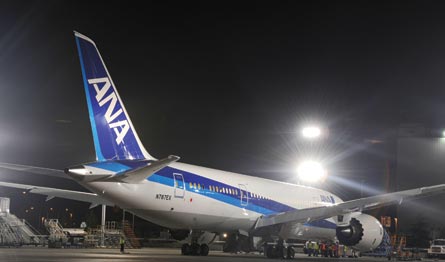A September handover is set for the first 787, say industry sources, the first of at least a dozen of the twinjets Boeing hopes to deliver in 2011 as it maintains its path to building 10 aircraft a month by the end of 2013.
Boeing declines to confirm the September delivery target. However, while reporting its full-year earnings, Boeing declared its intention to deliver a combined 25-40 747-8s and 787s this year, with a roughly 50-50 split in its guidance, part of a production target of 485-500 aircraft
Boeing announced on 18 January that certification and first delivery to Japan's All Nippon Airways has slid to the third quarter of 2011, following a November electrical fire that halted certification activities for six weeks.
Boeing chief executive Jim McNerney says "we're getting pretty close to knowing" which 787s will be ready for delivery, although programme sources say the fleet of aircraft between 10 and 22 require significant rework before delivery. Boeing says it has completed 75% of flight-test activities covering more than 2,500h on more than 800 flights.
 |
|---|
© Boeing |
Early candidates for delivery are believed to be Rolls-Royce Trent 1000-powered Airplanes Seven, Eight and Nine, to ANA, as well as Airplane 23 for General Electric GEnx-1B engine launch customer Japan Airlines.
Boeing has its 31st 787 in final assembly, and McNerney says the completion of assembly and travelled work of newly arrived structural shipsets continues to increase.
"We are now through a lot of the issues that caused some of the backed-up work," he says, and adds that engineering changes from flight test are "under control".
As for the overall production ramp-up, McNerney says that the margin for achieving the record widebody production rate has shrunk and the bulk of the increase to 10 787s a month will push into 2012, rather than 2011 as previously planned.
Boeing will activate its new Charleston, South Carolina final assembly line in July, followed by a second "surge line" in its Everett, Washington facility in early 2012.
Boeing aimed to achieve a rate of nearly three aircraft a month in the latter part of 2010, though this has since returned to two a month, a plateau, factory sources add, that is likely to run into mid-2011.
After more than three years of delays, Boeing chief financial officer James Bell says the programme remains in a position of profitability over its assumed accounting block, a number the company declines to disclose. However, says Bell, the continued delays have put pressure on programme profitability.
Source: Flight International























